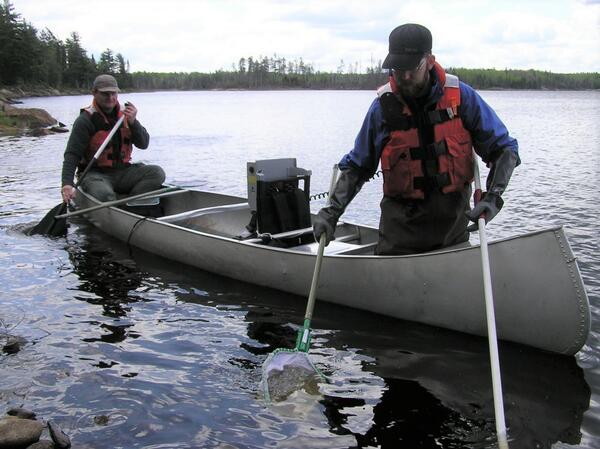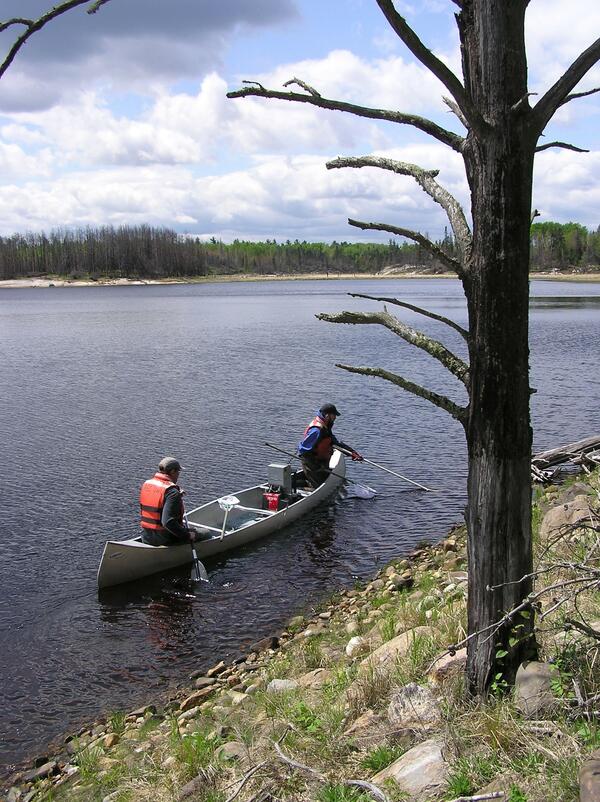Group photo of USGS Bemidi oil spill research team meeting in June of 2019 at Ruttgers Birchmont Lodge in Bemidji, MN.
Mark E Brigham (Former Employee)
Science and Products
Long-Term Monitoring Reveals How Water and Biota in Remote Lakes Respond Differently to Changes in Atmospheric Deposition of Mercury
Mercury
Comprehensive Assessment of Mercury in Streams Explains Major Sources, Cycling, and Effects
Complex Response to Decline in Atmospheric Deposition of Mercury
Chemicals of Emerging Concern in Water and Bottom Sediment in Great Lakes Tributaries, 2014 - Collection Methods, Analytical Methods, Quality Assurance Analyses, and Data Chemicals of Emerging Concern in Water and Bottom Sediment in Great Lakes Tributaries, 2014 - Collection Methods, Analytical Methods, Quality Assurance Analyses, and Data
Chemicals of Emerging Concern in Water and Bottom Sediment in Great Lakes Areas of Concern, 2013 - Analytical Methods, Collection Methods, Environmental Data, and Quality Assurance Chemicals of Emerging Concern in Water and Bottom Sediment in Great Lakes Areas of Concern, 2013 - Analytical Methods, Collection Methods, Environmental Data, and Quality Assurance
Group photo of USGS Bemidi oil spill research team meeting in June of 2019 at Ruttgers Birchmont Lodge in Bemidji, MN.

Scientists sampling fish from a canoe on Shoepack Lake
Scientists sampling fish from a canoe on Shoepack LakeMark Sandheinrich and Sean Bailey of the University of Wisconsin - La Crosse sampling fish from a canoe on Shoepack Lake in Voyageurs National Park.
Scientists sampling fish from a canoe on Shoepack Lake
Scientists sampling fish from a canoe on Shoepack LakeMark Sandheinrich and Sean Bailey of the University of Wisconsin - La Crosse sampling fish from a canoe on Shoepack Lake in Voyageurs National Park.

Scientists sampling for fish on Shoepack Lake via canoe
Scientists sampling for fish on Shoepack Lake via canoeMark Sandheinrich and Sean Bailey of the University of Wisconsin - La Crosse sampling fish from a canoe on Shoepack Lake in Voyageurs National Park. A burned tree is in the foreground from a previous wildland fire.
Scientists sampling for fish on Shoepack Lake via canoe
Scientists sampling for fish on Shoepack Lake via canoeMark Sandheinrich and Sean Bailey of the University of Wisconsin - La Crosse sampling fish from a canoe on Shoepack Lake in Voyageurs National Park. A burned tree is in the foreground from a previous wildland fire.
Analysis of groundwater and surface water in areas of isoxaflutole application, Tuscola and Kalamazoo Counties, Michigan Analysis of groundwater and surface water in areas of isoxaflutole application, Tuscola and Kalamazoo Counties, Michigan
Long-term trends in regional wet mercury deposition and lacustrine mercury concentrations in four lakes in Voyageurs National Park Long-term trends in regional wet mercury deposition and lacustrine mercury concentrations in four lakes in Voyageurs National Park
Methylmercury-Total mercury ratios in predator and primary consumer insects from Adirondack streams (New York, USA) Methylmercury-Total mercury ratios in predator and primary consumer insects from Adirondack streams (New York, USA)
Environmentally relevant chemical mixtures of concern in waters of United States tributaries to the Great Lakes Environmentally relevant chemical mixtures of concern in waters of United States tributaries to the Great Lakes
Drain tiles and groundwater resources: Understanding the relations Drain tiles and groundwater resources: Understanding the relations
Contaminants of emerging concern in tributaries to the Laurentian Great Lakes: I. Patterns of occurrence Contaminants of emerging concern in tributaries to the Laurentian Great Lakes: I. Patterns of occurrence
Contaminants of emerging concern in tributaries to the Laurentian Great Lakes: II. Biological consequences of exposure Contaminants of emerging concern in tributaries to the Laurentian Great Lakes: II. Biological consequences of exposure
Contaminants of emerging concern in the Great Lakes Basin: A report on sediment, water, and fish tissue chemistry collected in 2010-2012 Contaminants of emerging concern in the Great Lakes Basin: A report on sediment, water, and fish tissue chemistry collected in 2010-2012
Lake levels and water quality in comparison to fish mercury body burdens, Voyageurs National Park, Minnesota, 2013–15 Lake levels and water quality in comparison to fish mercury body burdens, Voyageurs National Park, Minnesota, 2013–15
Trends in mercury wet deposition and mercury air concentrations across the U.S. and Canada Trends in mercury wet deposition and mercury air concentrations across the U.S. and Canada
Hydraulic and biochemical gradients limit wetland mercury supply to an Adirondack stream Hydraulic and biochemical gradients limit wetland mercury supply to an Adirondack stream
Optimizing fish sampling for fish - mercury bioaccumulation factors Optimizing fish sampling for fish - mercury bioaccumulation factors
Science and Products
Long-Term Monitoring Reveals How Water and Biota in Remote Lakes Respond Differently to Changes in Atmospheric Deposition of Mercury
Mercury
Comprehensive Assessment of Mercury in Streams Explains Major Sources, Cycling, and Effects
Complex Response to Decline in Atmospheric Deposition of Mercury
Chemicals of Emerging Concern in Water and Bottom Sediment in Great Lakes Tributaries, 2014 - Collection Methods, Analytical Methods, Quality Assurance Analyses, and Data Chemicals of Emerging Concern in Water and Bottom Sediment in Great Lakes Tributaries, 2014 - Collection Methods, Analytical Methods, Quality Assurance Analyses, and Data
Chemicals of Emerging Concern in Water and Bottom Sediment in Great Lakes Areas of Concern, 2013 - Analytical Methods, Collection Methods, Environmental Data, and Quality Assurance Chemicals of Emerging Concern in Water and Bottom Sediment in Great Lakes Areas of Concern, 2013 - Analytical Methods, Collection Methods, Environmental Data, and Quality Assurance
Group photo of USGS Bemidi oil spill research team meeting in June of 2019 at Ruttgers Birchmont Lodge in Bemidji, MN.
Group photo of USGS Bemidi oil spill research team meeting in June of 2019 at Ruttgers Birchmont Lodge in Bemidji, MN.

Scientists sampling fish from a canoe on Shoepack Lake
Scientists sampling fish from a canoe on Shoepack LakeMark Sandheinrich and Sean Bailey of the University of Wisconsin - La Crosse sampling fish from a canoe on Shoepack Lake in Voyageurs National Park.
Scientists sampling fish from a canoe on Shoepack Lake
Scientists sampling fish from a canoe on Shoepack LakeMark Sandheinrich and Sean Bailey of the University of Wisconsin - La Crosse sampling fish from a canoe on Shoepack Lake in Voyageurs National Park.

Scientists sampling for fish on Shoepack Lake via canoe
Scientists sampling for fish on Shoepack Lake via canoeMark Sandheinrich and Sean Bailey of the University of Wisconsin - La Crosse sampling fish from a canoe on Shoepack Lake in Voyageurs National Park. A burned tree is in the foreground from a previous wildland fire.
Scientists sampling for fish on Shoepack Lake via canoe
Scientists sampling for fish on Shoepack Lake via canoeMark Sandheinrich and Sean Bailey of the University of Wisconsin - La Crosse sampling fish from a canoe on Shoepack Lake in Voyageurs National Park. A burned tree is in the foreground from a previous wildland fire.






